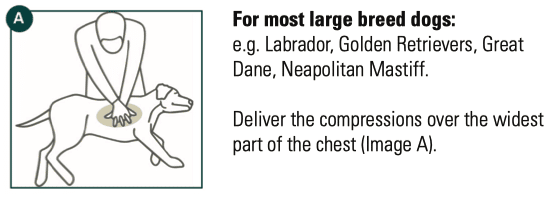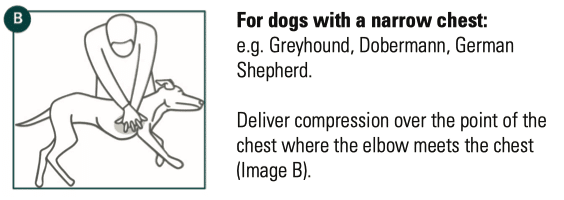Being in the position to have to administer CPR to your pet can be scary, but following the below guide will give you the know-how to safely and calmly perform CPR on your cat or dog.
Remaining calm
In the face of a pet emergency, oftentimes a natural reaction is to panic – this is your body’s fight or flight reaction to stress. Regardless of whether you have delivered CPR to a pet before, it is important to follow these steps to clearly and calmly assess the situation at hand.
- If you find yourself panicking, take a few deep breaths. Take a deep breath and focus on the feeling of air filling your tummy, breathe out, and continue for at least three breaths.
- Focus on the tasks at hand. If there are by-standers, give them a task – such as finding the closest emergency vet, getting directions, and calling them to let them know you’re arriving.
- Read through the below guide, and focus on mindfully performing the action of the task at hand. Notice how your body feels, the sensations occurring throughout your limbs, and focus your mind on counting the compressions and breaths.
When to start
- When your pet is not responding
- When your pet is not breathing
- When you can’t feel a heartbeat or pulse
Compressions
- Place your pet on their side
- Deliver 120 compressions per minute (2 compressions per second)
- With every 30 compressions deliver 2 breaths
- See below compression techniques for instructions on how to do this, making sure to follow the technique best suited to the size of your pet
- Don’t lean on your pet between compressions as this will stop blood returning to the heart
Breaths
- Close your pets mouth and create a seal by wrapping your fingers around the muzzle
- Place your mouth over the whole nose, covering both nostrils
- Give 2 breaths, enough to make the chest rise
- After 2 minutes of compressions and breaths, check your pet for a heartbeat or pulse – if not present, then continue
When to stop CPR
- If your pet starts breathing and responding
- Once you have reached your vet clinic and someone else takes over
- If you are unable to physically continue
If your pet starts breathing but remains unconscious
- Turn your pet onto their side into the recovery position
- Continually check your pets condition until you have arrived at your vet clinic
- Manage any concurrent injuries
- Be prepared to start CPR again if necessary
Recovery position
- Place your pets head on its side
- Tilt your pets head down slightly unless they have sustained trauma to the head, in whcih case tilt the head slightly up
Compression techniques
Follow the below compression techniques depending on the size of the animal.
CPR Compression techniques for medium to large dogs
- Compress (or press down) to one third the depth of the chest and allow full recoil of the chest between compressions
- For most large breed dogs (e.g labrador, golden retriever, great dane, neapolitan mastiff) – deliver the compressions over the widest part of the chest (image A)
- For dogs with a narrow chest (e.g greyhound, dobermann, German shepherd) – deliver the compressions over the point of the chest where the elbow meets the chest (image B)
- For dogs with a barrel chest (e.g bulldog) – lay your pet on their back and compress over the sternum (image C)
CPR Compression techniques for small dogs/cats
Use this method for smaller dogs or cats (e.g maltese terrier, chihuahua, shih tzu, italian greyhoud).
- Using a single hand, apply compression using the thumb on one side of the chest and the fingers on the other side of the chest (image D) OR compress over the heart (image E).
The techniques outlined above are suitable in a single responder scenario. A different approach would be used if there were 2 or more resuscitators.
If your pet is not breathing or is unresponsive visit your closest Animal Emergency Service or your local vet immediately.
For more information about what is and what to do in a pet emergency, visit our Pet Emergency Guide.




